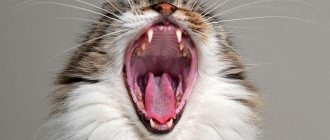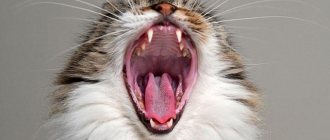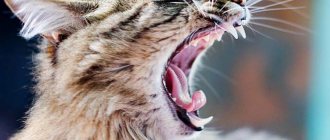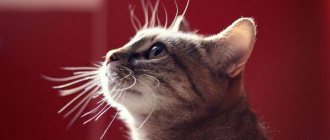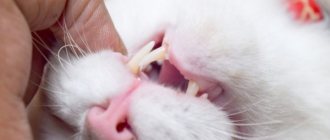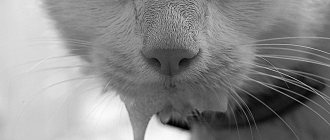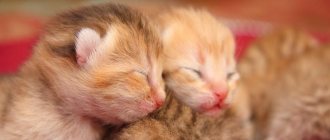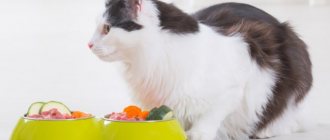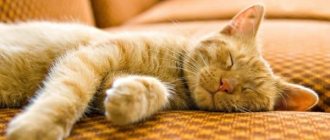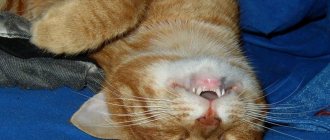Symptoms accompanying tooth loss
When the problem is detected at an early stage, treatment is successful. Owners monitor the behavior of their pets in order to notice the symptoms of dental disease in cats in time and begin treatment.
At the veterinarian's appointment
Chewing hurts for a cat
She refuses to eat or chews carefully so as not to touch the sore spot. Becomes aggressive and irritable. Bites and scratches the owner
Meows anxiously. He rubs his face with his paw, washes himself, shakes his head - perhaps the cat’s fang has fallen out. Sits with his mouth open.
The owner must examine the gums and tongue. If there are abscesses and bumps on the jaws, there is an unpleasant odor from the mouth - these are symptoms of diseased incisors.
Saliva flows profusely, the gums are swollen and red. Blood and pus from the mouth are a reason to seek medical help.
When an old cat’s teeth are loose, they don’t think twice about what to do - go to the veterinarian. The clinic relieves suffering for older animals.
Important! Dental problems begin gradually. An attentive owner notices symptoms in time
Treatment in the initial stages of the disease keeps the cat healthy.
Diagnosis and treatment
A veterinarian can decide what to do if a cat's tooth falls out only after making an accurate diagnosis. To do this, he does:
- collection of anamnestic data;
- examination of the oral cavity;
- fluoroscopy.
If the presence of internal pathologies is established, the doctor may prescribe laboratory blood tests and ultrasound of internal organs. Then treatment is prescribed depending on the disease and the presence of accompanying symptoms:
- removal of tartar (if necessary);
- elimination of inflammation of the soft tissues of the oral cavity;
- filling or removal;
- correction of diet;
- elimination of systemic disease (if present).
A veterinarian may prescribe a special diet or introduce vitamin and mineral complexes into the diet.
Features of tooth growth in kittens
An adult healthy cat has three dozen permanent teeth in its mouth (kittens have 4 fewer - 26 in total) - 12 incisors on the upper and lower jaws, 4 canines, 3 molars at the top and 4 at the bottom. And all of them should be white or cream, strong, without signs of inflammation or destruction. And the gums are pink
Much here depends on the quality of the animal’s nutrition, but it is also important on when and how the kitten’s teeth were changed and what kind of care the owners provided him during that period
When do cats' teeth change?
Owners who have recently adopted a small cat into their home constantly ask veterinarians and specialized online forums: when do kittens’ teeth change? Meanwhile, the owners will be the first to know that the pet’s incisors, canines, premolars and molars have begun to change. And to do this, you don’t even have to look into the animal’s mouth.
A kitten whose teeth change dramatically changes its own behavior. He becomes restless, meows often and loudly, informing his owners of discomfort. And the little cat begins to chew everything. Slippers - so slippers, wires - so wires, the owner's hands - that means arms, or even legs! Anything your heart desires can end up in a cat's itchy mouth. Rags, toys, books (especially those that are thicker, with “appetizing” voluminous spines), pencils and computer mice... It’s an eye-catcher!
In general, during the period when kittens’ teeth are changing, owners are required to pay close attention and control over the pet’s behavior. And also competent thoughtful care. Starting with nutrition and ending with careful hygiene of the cat’s mouth
This is necessary so that the cat’s permanent teeth grow strong and correctly, and the gums and mucous membranes remain free of inflammatory processes.
Starting with nutrition and ending with careful hygiene of the cat’s mouth. This is necessary so that the cat’s permanent teeth grow strong and correctly, and the gums and mucous membranes remain free of inflammatory processes.
At the age of 3-4 or even 5 months (much depends on the breed and on the individual development of a particular individual), cats’ teeth begin to change. This happens gradually, one might say in stages - first the incisors change, followed by the canines, and then the turn comes to the premolars and molars. And by seven months, the “dental exchange” ends in almost all domestic felines.
Of course, anyone who gets a cat must know everything about the change of teeth in kittens - when and how this happens, in order to provide special nutrition for their mustache during this period. In general, during this difficult period the animal requires special care and maximum attention from the owner.
Do kittens lose their baby teeth?
Yes, kittens are just like little guys. And tiny sharp teeth change in the same way - milk teeth fall out, permanent teeth grow. Therefore, the question that is relevant for many owners: do kittens lose their baby teeth can be answered with confidence in the affirmative. Moreover, if for some reason not all of a cat’s non-permanent teeth have fallen out, then they will have to be removed by a veterinarian.
Why delete? Yes, because excess teeth in the animal’s oral cavity can lead to injury to soft gums, the formation of wounds and ulcers on the mucous membrane. In addition, more serious problems with the bite and even with the bone tissue of the cat's jaw may arise. And such a “trifle” as periodontal disease is definitely guaranteed for your pet.
Caring for a kitten during the period of teeth change
The period of changing teeth can really become a test for an inexperienced owner. However, it is necessary to understand that the animal is not sick, does not need to take medications and constant visits from veterinarians. Most often, for a cat, everything happens, if not unnoticed, then at least painlessly.
There is no need to allow the kitten to chew furniture, spoil things, and especially not to bite and scratch you. In the future, this habit could become a really serious problem. Changing teeth is a natural process for an animal; therefore, the initially established rules of behavior must be preserved.
However, the task of every responsible owner is to make this period easier for the animal, take care of proper nutrition, brushing teeth and the availability of special toys.
Special food
A kitten needs proper and complete nutrition . However, despite the abundance of food created specifically for the period of teeth change, the animal may react negatively to a sudden change in food. Therefore, you need to ensure that your pet has the necessary vitamins and supplements in its diet, thanks to which permanent teeth will grow strong.
There are nutritional principles that must be followed when a kitten’s teeth change:
- First of all, you need to avoid overly soft food: kittens can swallow lost teeth along with soft food, which can lead to damage to the esophagus. The food should be large and slightly rough. Regular dry food for kittens is ideal.
Dry food is the best option during teeth change
- Large pieces of meat (beef, turkey, chicken, rabbit) scalded or boiled, cut into small pieces, are also ideal for a kitten.
- You need to include cottage cheese and other fermented milk products that are rich in calcium in your diet.
- The kitten needs calcium and phosphorus; they can be given as supplements to the main diet. At the pet store you can find both drops and small tablets that can be added to food. Such supplements also contain a little analgesic so that the kitten does not experience severe pain.
- A maximum of twice a week, you can give your kitten low-fat boiled sea fish, for example, hake. However, you should not overuse fish, even though it is rich in phosphorus.
- Meat or fish should be given mixed with cereals: oatmeal, buckwheat or rice. It is also useful to add some vegetables, such as carrots, zucchini or pumpkin, both raw and boiled.
- The diet should also include sufficient amounts of vitamins A and D.
- The kitten will try to chew everything, including your things, so it’s worth purchasing special bones. They contain the necessary vitamin supplements, and in fact the kitten gets the opportunity not only to strengthen its teeth, but also the necessary amount of vitamins supplied with saliva.
Bones are an important part of the diet and serve to prevent the kitten from chewing your things.
Veterinarians advise not to mix natural food (meat, fish, vegetables, etc.) and dry food. If you switched your kitten to dry food at an early age, then you should stick to it. The fact is that these types of food are digested differently, and when mixed, the kitten may experience bloating or even colic.
When choosing a feeding method, you should consult a veterinarian: each pet is individual, many may not be suitable for dry or natural food
Vaccination during the period of teeth change
Very often, owners are faced with an important question: is it possible to get vaccinations or other vaccinations while changing teeth? Veterinarians speak out unequivocally - changing teeth is already a serious burden for a kitten. Against the backdrop of fever and pain, getting vaccinated can be dangerous. This not only adversely affects the kitten’s immune system, but also leads to stunted growth of the animal.
Vaccination during the period of teeth change is not recommended.
It is important to follow the vaccination schedule for your pets as prescribed by your doctor. The vaccination schedule is set individually, taking into account the age characteristics of the body and physiological state.
My kitten was scheduled for the first vaccination very late. This was due to the fact that he was found on the street and many tests had to be done to assess his health. The time for his vaccination was due to change his teeth, so it had to be postponed for a while (until the temperature passed and slight inflammation of the gums subsided).
Teeth cleaning
Many owners ignore brushing their teeth. However, constant oral care will help keep your animal's teeth strong. It is necessary to accustom your cat to brushing its teeth from the early months of life so that in the future it will adequately perceive this procedure. If the cat refuses to accept traditional brushing with a toothbrush or powder, pet stores sell special gels for disinfecting the oral cavity. You can combine them with special foods and vitamins that include coarse fibers. It is recommended to brush your teeth once every three to four weeks.
Brushing your teeth is an important procedure that your kitten needs to be accustomed to.
During the change of teeth, kittens' gums can become inflamed, so you need to purchase a gel that also contains an anesthetic and anti-inflammatory, which can greatly alleviate your pet's condition.
Consequences of tooth extraction
Complications are possible after the removal procedure. You will immediately understand that your animal is experiencing discomfort or pain. The cat will refuse to eat, will worry, meow loudly, and rush around the house.
Common complications include the following:
Alveolitis. Bad breath, refusal to eat, quickly swallowing pieces without chewing are signs of gum inflammation. The treatment is quick and painless. The doctor cleans the inflamed hole and applies a bandage with disinfecting ointment.
Bleeding. If there is excessive bleeding, the hole must be sutured.
Jaw fracture. It can only be detected by injury during removal, if the doctor applied too much physical force to the jaw.
Unfortunately, tooth extraction in cats is quite common, since many animal owners, out of ignorance, do not care for the cat’s oral cavity. Therefore, they come to the clinic with advanced cases and the teeth are removed.
Tooth extraction in cats occurs only when treatment no longer helps. It must be remembered that many dental diseases are asymptomatic, so it is necessary to periodically examine the oral cavity so that you do not have to resort to such a procedure.
Let's look at the cases in which teeth are removed.
- Incorrect placement of milk or molars, which interferes with the normal functioning of the animal - the soft tissues of the oral cavity are damaged.
- In severe cases, where conventional treatment has not yielded results - feline lymphoplasmacytic stomatitis.
- Teeth that are close to each other is called crowding. In this case, there is a risk of getting sick because Food will accumulate between the teeth and this will lead to an inflammatory process.
- Internal root resorption
- External root resorption
- Milk teeth that did not fall out on time on their own, but the molars have already begun to grow and the milk teeth interfere with the growth of new teeth.
- Teeth located under the gum mucosa are also subject to removal. They have not erupted, but a cyst may form under the gum and this will harm the adjacent teeth.
- The indication for tooth extraction is periodontal disease.
- Odontoclastic resorptive lesion of teeth – classes 2,3,4
Tooth extraction is carried out only under anesthesia. After tooth extraction, your pet must have the wound sutured, otherwise there is a risk of infection, and the wound will take a long time to heal.
Features of the cat's dental system
The cat is a predator that hunts small rodents, kills them and eats their flesh. Due to this form of nutrition, the dental system of a predator has a special structure. The incisors are practically not involved in hunting and chewing food and therefore are small in size. Cats use them to catch fleas and bite dirt out of their fur coats.
The most significant in size are the fangs. These long, sharp teeth are essential for holding onto caught prey. They are slightly curved inside the oral cavity and are also used for protection. The loss of fangs is tantamount to the loss of weapons. A predator cannot kill its prey and tear it apart. If the fangs are lost, the animal will have to be content with carrion.
Molars and premolars are saw-shaped. Their sharp cutting edges help to cut meat and cut it off the bones. Due to the lever action of the jaw joints, the cheek teeth act like scissors. The upper part of the crown of a cat's cheek tooth is sharper than that of some members of the canine family.
The cat does not chew its food because it is not necessary. Her saliva does not contain digestive enzymes. The enzymes needed to digest protein foods could also dissolve oral tissue. Therefore, predators simply swallow large pieces.
Natural selection is very rational and cruel, therefore, in the wild, a predator that has lost the ability to feed and defend itself dies.
Prevention of tooth loss
Preventing the loss of incisors is easier than treating a pet’s diseased chewing apparatus:
- Diet. Canned food does not clean tooth enamel. A plaque appears. Therefore, they give food with solid particles, rich in vitamins and minerals.
- Oral hygiene. Brush your teeth with a soft brush with a paste that tastes and smells like meat. This needs to be done as a daily procedure.
- Show it to the vet. He detects the problem, helps, and gives recommendations.
- Treat gum diseases. Strengthening herbal decoctions, gels, and ointments are used.
Pets suffer from toothache when the owners are not attentive enough to them: they do not notice injuries to the oral cavity, they neglect hygiene. Eating only soft canned food leads to the formation of plaque, and subsequently forms tartar. Lack of vitamins, weakened immunity, infections are the causes of dental problems.
The first signs of the disease - drooling, bleeding gums, unpleasant odor from the mouth - are a reason to consult a doctor. A good owner does not put off visiting the veterinarian and tries to cure his animal as quickly as possible.
Diet for a kitten
During the period of bone tissue formation, food should contain a sufficient amount of calcium and fluorine. A lack of mineral elements will cause delayed, uneven tooth replacement. Dry food for kittens contains all the necessary mineral supplements and will be useful as crackers for massaging swollen gums. The kitten may refuse to eat because they are sore, but this may not last long. A cat, as a predator by nature, cannot starve for more than 2 days. A small cat will only be able to skip one feeding. If he continues to starve, then you need to contact your veterinarian.
© shutterstock
Help with tooth loss
What to do if a kitten loses a tooth? It is difficult to give a definite answer to this question. Solution methods depend on the reason that led to the occurrence of this problem. In most cases, canine loss in a pet can be a consequence of mechanical trauma. In this situation, the breeder will need to sanitize the wound and monitor the healing process, if possible preventing the development of complications. But there are situations when it is not possible to immediately understand the cause of tooth loss in kittens. In this case, only systematic observation of animals can help. Any deviations in your pet's behavior may indicate a serious illness.
Measures to help your pet depend on the pathological or physiological process occurring in its body and may include:
· Weekly cleaning of tooth enamel.
· Therapy of carious cavities.
· Sanitation of the oral cavity.
· Balanced diet.
· Strengthening the immune system with the help of special medications.
· Therapy of the underlying pathology.
In cases where the breeder does not have sufficient experience and does not know what to do if the kitten’s teeth fall out, it is necessary to contact a veterinary clinic as soon as possible. In a specialized institution, your pet will be provided with the entire necessary range of treatment measures.
What to do
Of course, you shouldn’t sit and wait for the pain and discomfort in the area of a tooth overgrown with gums to go away on its own. It is best to immediately contact a specialized dental clinic for medical advice. Only he will be able to conduct a comprehensive examination of the oral cavity, prescribe the necessary tests, conduct an X-ray examination and prescribe the correct treatment.
As a rule, a broken tooth that is overgrown with soft tissue is carefully removed. This requires making an incision in the gum. If the tooth is healthy, then after opening the hole the doctor can install an artificial root and prosthesis into it.
If it is not possible to save the tooth, then a procedure is performed to extract its root system. To do this, the specialist uses a special tool called an elevator, with which he cuts the top of the unit and gradually brings it to the surface. Such manipulations are carried out under local anesthesia and do not take much time. After extraction of a diseased tooth, a medicinal drug can be applied to the wound, which promotes faster healing. The stitches are removed after a few weeks.
When is veterinary help needed?
The owner should focus on the pet’s well-being and his own common sense. Often, symptoms when kittens change teeth make the owner worry about the baby’s health.
Veterinarians are quite loyal to situations when the owner brings a healthy kitten to the appointment to make sure that everything is fine with him. This is definitely better than not seeing a doctor when you definitely need his help.
Regarding the change of teeth, a veterinarian is definitely needed in the following situations:
- the wound on the site of the former baby tooth has festered;
- the cat meows pitifully, cannot sleep, is worried;
- the animal is very lethargic;
- the kitten does not eat for more than a day;
- the baby's mouth smells bad;
- the gums are very inflamed;
- a new tooth or an old one displaced under its influence injures the kitten;
- the baby tooth never fell out, but the gums around it were inflamed;
- the cat has not gone to the toilet for more than a day (he scratched his teeth on something, bit off a piece, and it got stuck in the intestines);
- Some of the baby teeth have not fallen out, although the permanent ones have already grown in and the time for changing teeth has passed.
Deterioration in health cannot always be attributed to the teeth; perhaps the pet is sick. A doctor's consultation will be required in the following situations:
- The smell becomes disgusting, which signals severe inflammation and the development of periodontal disease.
- The kitten sleeps poorly, does not eat for more than a day, and becomes apathetic or restless. A possible reason for this behavior is severe pain in the gums.
- Saliva is secreted excessively, thickens, hangs out of the mouth, which causes the fur on the chest to become wet. This indicates a possible inflammation of the oral mucosa - gingivitis, stomatitis.
The pet's mouth is regularly examined; normally, the surfaces remain smooth, pink, and without damage. Help is needed when deviations are noticed:
- the gum is inflamed around the temporary tooth;
- the hole festered;
- the “milk jug” has shifted and injures the mucous surfaces;
- some children’s teeth remain when the permanent ones are fully grown;
- after 7 months a double row was formed;
- The gums are red and bleeding.
In case of inflammation, they do not give medicine, but take the pet to the clinic. Only a veterinarian will be able to properly examine the mouth, assess the degree of inflammation, and prescribe medications without harm to the animal’s health. “Excess” teeth are removed in the clinic under anesthesia if they damage the mucous membranes, form an incorrect bite, or remain in the mouth after 8–9 months. Stunted growth, when milk has already fallen out, indicates a lack of microelements.
Advice from a veterinarian-dentist
Removal of any fixed teeth, no matter whether they are temporary or permanent, must be carried out using anesthesia and analgesia. Dental pain is a moderate pain and proper analgesia is required for every patient.
To the question, is it possible to anoint the gums with something anesthetic or give them local anesthesia like in humans, I will answer right away - no, it is not possible.
Local analgesic gels will anesthetize the mucous membrane of the gums and tongue and increase salivation in the dog, which can lead to vomiting and aspiration of vomit into the trachea, and in cats their use is even more dangerous, since such gels can lead to laryngospasm and respiratory arrest. Unfortunately, a local injection into the gum cannot be carried out without the use of sedatives that induce sleep. I have a hard time imagining a cat or dog whose gum someone tries to stick a needle into. But even if this happened, after such an injection no patient will ever be allowed near him again.
Gil Veronika Yurievna, veterinarian, surgeon, dentist
https://gilvet.ru/stati/molochnye-zuby-u-sobak-i-koshek/
Captive temporary teeth, which are already being replaced by permanent teeth, are called persistent and must be removed at the first visible changes in the bite.
It is impossible to leave persistent teeth, because the dentition of an adult dog is designed for 42 teeth, and for a cat 30, and if there are more teeth, periodontitis will begin... The age for removing baby teeth is not a specific number. Everything happens individually for each animal, and to say, for example, that the optimal age is 8 months is wrong. Each animal has a different age for extraction; some require removal of persistent teeth as early as 5 months of age.
Gil Veronika Yurievna, veterinarian, surgeon
https://gilvet.ru/stati/molochnye-zuby-u-sobak-i-koshek/
In some puppies and kittens, the change of teeth occurs with an increase in body temperature and a decrease in appetite, sometimes even with a refusal to feed. In such situations, it is better to consult a doctor for help.
In cats, during the change of teeth, a very strong odor from the oral cavity is not a strong pathology, and if you see double rows of teeth (both permanent and temporary), know that this occurs normally. But if you notice that your permanent teeth are starting to grow and interfere with each other, you need to consult a specialist.
Gil Veronika Yurievna, veterinarian, surgeon, dentist
https://gilvet.ru/stati/molochnye-zuby-u-sobak-i-koshek/
If they removed temporary teeth and broke the crown, leaving the root in the gum with the words “it will resolve on its own,” I answer - no, it will not resolve.
Why should the root of a tooth dissolve because you have broken the crown? It will remain in the gums as a foreign body and at a certain time can cause the process of periodontitis of adjacent teeth or osteomyelitis of the jaw bones...
With any injury to the crown of a temporary canine, traumatic pulpitis occurs, and as a result, periodontitis develops with an abscess on the jaw, inside of which there is a rudiment of a permanent canine. Trauma, pain, inflammation and the possible loss of not only a temporary, but also a permanent canine - this is the price to pay for an incompetent attempt at self-medication.
In case of traumatic pulpitis of a temporary canine, the tooth must be immediately extracted (removed).
Gil Veronika Yurievna, veterinarian, surgeon, dentist
https://gilvet.ru/stati/molochnye-zuby-u-sobak-i-koshek/
If the temporary tooth is mobile and “almost transparent to the light”, there is no need to remove it at all - let the animal chew on something in which to sink the teeth (for example, a not very hard “chew” or a large treat), and, believe me, the tooth will fall out on its own .
Gil Veronika Yurievna, veterinarian, surgeon, dentist
gilvet.ru/stati/molochnye-zuby-u-sobak-i-koshek/
Video: cat dental care
Formation of primary dental occlusion
Almost all mammals are born toothless. Cats are no exception: the oral apparatus of a newborn kitten is maximally adapted for effective sucking. After all, the only food available to him is mother’s milk.
At two weeks of age, kittens develop milk teeth - straight, small, sharp, milky white. In adult cats they are powerful and curved. They are called milk teeth because they appear in kittens during breastfeeding.
Interesting! The front milk teeth of kittens are straight, and the fangs are curved.
Teething order
The eruption period lasts up to two months. By this age, the cat already has 26 baby teeth. They do not appear all at once, but in a certain order:
- 2–4 weeks. Incisors appear. First, 2 in the center of the jaw, then 4 more are added to them on both sides. There are 12 incisors in total - 6 each on top and bottom.
- 3–4 weeks. Fangs appear: 4 upper and 4 lower. They are located on the sides of the incisors.
- 4–8 weeks. The appearance of pre-masticating teeth - premolars: 4 on the lower jaw and 6 on the upper jaw.
Important! Milk teeth will serve kittens up to the age of 3-4 months with proper care and timely introduction of complementary foods.
